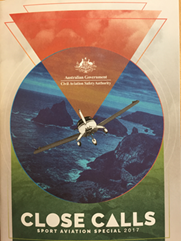 The Civil Aviation Safety Authority here in Australia (our version of the US’ FAA) prints a number of “Close Calls” stories in their various publications. The objective is to present stories where a pilot came close to an accident so that other pilots can learn from the mistakes that were made. Having read a number of these stories I can attest to their benefit as I’ve taken on some of the lessons and have recognised scenarios that, had I continued my flight, may well have put me in a similar (or worse) situation.
The Civil Aviation Safety Authority here in Australia (our version of the US’ FAA) prints a number of “Close Calls” stories in their various publications. The objective is to present stories where a pilot came close to an accident so that other pilots can learn from the mistakes that were made. Having read a number of these stories I can attest to their benefit as I’ve taken on some of the lessons and have recognised scenarios that, had I continued my flight, may well have put me in a similar (or worse) situation.
Given this, it was relatively easy to agree to provide an article for CASA’s 2017 Sport Aviation Close Calls booklet. The Sport Aviation people wanted to get close call stories from various executives & staff members within the Sport Aviation Organisations, such as RA-Aus, the Glider Federation of Australia, the ABF, etc. With my role as Operations Manager for the ABF and an existing article that I’d recently had published in the ABF’s Aeronotes magazine, my story was just what they were after.
Imagine when my surprise when not only was it published but it also appeared as the first story in the collection. Woo hoo :)
I’ve included the text below in case you want to read it. It’s not a long story but it does help point out the concerns associated with low flight, even in a relatively slow moving balloon!
Close Call at Bungendore
We’ve all been told again & again about being vigilant for powerlines & looking out for the poles rather than the wires. Some of us even make it a rule to not fly below powerline height except on our final approach to land.
While I’ve previously had a couple of “powerline moments†in the past, both of them were easily avoided and could be anticipated based on surroundings (eg: a pumping station near a lake had a SWER heading across a field, a set of powerlines were running along a road but the poles were hidden by trees, etc). We’re taught to look for these clues and generally do a good job of avoiding wire strikes.
My latest encounter with a powerline was a big surprise and could have been a major concern if the paddock I’d been flying over was one where I was landing.
While flying with other balloons at Bungendore near Canberra I was looking for more steerage to the right of our target in anticipation of the winds taking us left of the target later in the flight. I was flying over a large paddock with rows of powerlines running up the left and right sides (see diagram) and had dropped down with the basket about 20’ off the ground to see if I could get “more right.â€Looking at the power poles running either side of the paddock, it appeared that the lines were running parallel to my direction of travel. There did not appear to be any indication (nor expectation) that the two parallel sets would be connected in any way.
While flying up the paddock I noticed horses ahead in another paddock near a house so, using the quiet burner, commenced a gentle ascent. At about 60-70’ above the ground my passenger said “Power line!†so I immediately triggered the blast valve & increased our rate of ascent. I was then able to see the power line against the background and realised it was still a fair distance away. We would have cleared it had I continued the gentle ascent on the quiet burner but, had I not initiated the climb we may never have seen the line and would have experienced a very surprising wire strike event.
So, why was there a powerline running across the paddock? As per the diagram, there was a spur running off to a building some distance away. Rather than just run the spur from the powerlines running along the road, a line was transferred from the lines on the other side of the paddock over to the lines along the road and then off to the building. What the reasoning was behind this transfer line is not known to me at this time.
For myself it was very unexpected, quite eye opening and I’ll certainly think twice before dropping down below power-line height even if I think I’ve identified all the powerline tracks in the vicinity.


